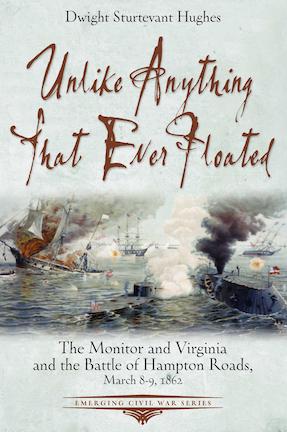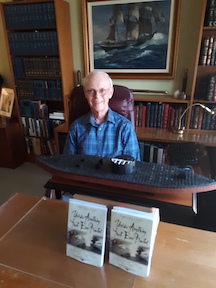The ECW Series Gets Naval: Prepare for the clash of the ironclads!
 The clash of the Monitor vs. the Merrimack—the alliterative “M’s” made for a catchy hook for many of us as kids!—is one of the best-known stories of the Civil War: two iron sea beasts trading explosive blows, battling to a draw in an epic dual that remade naval warfare.
The clash of the Monitor vs. the Merrimack—the alliterative “M’s” made for a catchy hook for many of us as kids!—is one of the best-known stories of the Civil War: two iron sea beasts trading explosive blows, battling to a draw in an epic dual that remade naval warfare.
Alliterative “M’s” aside, the match-up between the Monitor and the Virginia in the battle of Hampton Roads has become legendary. And who better to tell the tale for the Emerging Civil War Series than ECW’s own naval expert, Dwight Hughes?
Unlike Anything that Ever Floated is now available from publisher Savas Beatie, Amazon, Barnes and Noble, and other great booksellers. It’s the 35th book in the Emerging Civil War Series, and the first one solely devoted to a naval story. (We’re working on more.)
After the long, COVID-triggered pause in our publishing schedule, we’re pleased to finally be rolling out books again, but of course, no one was more pleased that Dwight, who looked like a kid at Christmas when his books first arrived:
 To celebrate the book’s publication, Dwight even commissioned the creation of a scale model of the Monitor—cool beans!
To celebrate the book’s publication, Dwight even commissioned the creation of a scale model of the Monitor—cool beans!
About the Book:
“Ironclad against ironclad, we maneuvered about the bay here and went at each other with mutual fierceness,” reported Chief Engineer Alban Stimers following that momentous engagement between the USS Monitor and the CSS Virginia (ex USS Merrimack) in Hampton Roads, Sunday, March 9, 1862.
The day before, the Rebel ironclad ram had obliterated two major Union warships and was poised to destroy more. That night, the revolutionary—not to say bizarre—Monitor slipped into harbor after a hurried voyage from New York through fierce gales that almost sank her. These metal monstrosities dueled in the morning, pounding away for hours with little damage to either. Who won is still debated.
Monitor became an icon of American industrial ingenuity and strength. She redefined the relationship between men and machines in war, challenging ancient concepts of honor and valor. “There isn’t danger enough to give us any glory,” wrote one officer. But beforehand, many feared she would not float. Captain John L. Worden: “Here was an unknown, untried vessel…an iron coffin-like ship of which the gloomiest predictions were made.”
The CSS Virginia was a paradigm of Confederate strategy and execution—the brainchild of innovative, dedicated, and courageous men, but the victim of hurried design, untested technology, poor planning and coordination, and a dearth of critical resources. Nevertheless, she obsolesced the entire U.S Navy, threatened the strategically vital blockade, and disrupted General McClellan’s plans to take Richmond.
From flaming, bloody decks of sinking ships, to the dim confines of the first rotating armored turret, to the smoky depths of a Rebel gundeck—with shells screaming, clanging, booming, and splashing all around—to the office of a worried president with his cabinet peering down the Potomac for a Rebel monster, this dramatic story unfolds primarily through the accounts of men who lived it.
About the Author:
Dwight Sturtevant Hughes writes and speaks on Civil War naval history (www.CivilWarNavyHistory.com). Lieutenant Commander Hughes graduated from the Naval Academy in 1967 and served twenty years aboard warships, on navy staffs, and with river forces in Vietnam. He holds an MA in Political Science and an MS in Information Systems Management. Dwight authored A Confederate Biography: The Cruise of the CSS Shenandoah (Naval Institute Press, 2015) and is a contributing author at the Emerging Civil War blog. He has presented at numerous Civil War Roundtables, historical conferences, and other venues.
We’re looking forward to Mr. Hughes scheduled appearance before our group.. I just ordered this new book of his. Can’t wait to check it out. See you soon Mr. Hughes!
When I saw this come out I got it and read it immediately. Really good book. Also does a great job of addressing the strategic security environment at the time of the outbreak of the way and showed the Navy’s place in that environment.
If you guys keep producing navy Civil War books I will read every last one! Navy needs more attention for its role in the war.
I agree. This book is excellent – some of the diagrams and images are alone worth the price. The author also does a great job of fitting these vessels into the larger and developing ironclad context at the time.